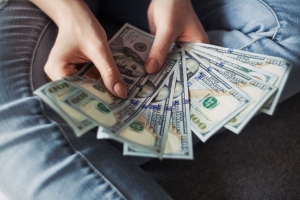
I was introduced to Uber in 2011, in a casual conversation with an early investor there, just before Uber took off big-time. That person was excited by how easy it was to order a ride from an airport just a few days earlier, in a nice limousine. Then I was told that Uber was a perfect option for someone who might have an upscale car, with payments still due, but with a well-paying job gone due to the recession. That person likely, most of the time, searched for a new job, but for a few hours per day could take time off and work as a driver for Uber. A few hundred dollars earned this way could help during the financial downturn, covering car payments, for example.
This is not the concept of Uber as we know it now. But I see a similar approach in the original pitch deck as disclosed by Garrett Camp, the Uber co-founder. In late 2008 Uber founders noticed that new mobile phone technology allowed for creating a simple application for car ride-sharing that was much easier and more efficient than the anachronistic taxi dispatching system. The timing could not have been better. Between the beginning of 2008 and the end of 2009, 7.5 million Americans lost their jobs. Many of them had car payments still due, and eagerly jumped on the Uber opportunity. In their economic calculation, the only cost of driving for Uber was the cost of gas. They did not count how much they were making per hour; they valued the convenience of doing it when they needed it and for however long they were willing to do it. Their income objective was that extra few hundred dollars per week they desperately needed.
Things changed when the economy bounced back. There are very few people with nice cars and an abundance of time. Most people who can afford a nice car usually have an occupation with an income supporting this purchase. If they need extra income, usually they can make more by exploring their professional field than by downgrading to the relatively low-skill job of a personal driver.
I recall a conversation with a friend who drives for Uber part-time. He has a modest income from his primary job and is very entrepreneurial in finding additional sources of income. He seemed content with his income from driving for Uber. I asked him if he accounted for all his costs: the wear and tear on the car, insurance, the higher risk of accidents and his time of idle driving. After taking all these factors under consideration, in a similar manner as one can find it on the internet, we concluded that his income is about $10 per hour, if not less. He did not realize that. He has skills and opportunities to make much more by doing other things. I would not be surprised if many people still drive for Uber only because, like my friend, they do not know the basics of business accounting.
The calculation is even worse for those who try driving for Uber as their primary source of income. After all bills are paid, they see clearly that there is not enough money left. Instead of leaving for jobs elsewhere, Uber drivers turned to the government for help in securing at least a minimum wage. New York set it recently at $17.22 per hour; California is tinkering with setting it at $21 per hour.
The irony is that history made a full cycle. Ride-sharing rose to popularity in response to an overregulated taxi industry. In major American cities, where most of the taxi driving takes place, one needs to buy a medallion in order to drive a taxi. That medallion is a city permit to operate a taxi service. By limiting the issuance of these permits, cities limit taxi traffic and, by curbing competition, help maintain a higher income for taxi drivers. With a limited supply, these medallions reached astronomical prices, up to several hundred thousand dollars, touching even $1 million in New York.
All that bureaucratic reality fell to pieces with the disruption caused by Uber and Lyft. Now, taxi medallions can be bought for one-tenth of what they were worth just a few years ago. Also, after all the glitter of the gig economy has faded, the bare truth emerged that passenger riding, be it in an old-fashioned taxi or a new ride-share, offer just a minimum-wage income. Uber drivers, who originally benefited from playing in an unregulated field, asked the government for regulations.
Uber catapulted to its prominence because, during the recession, we had an oversupply of drivers who, hungry for cash, were willing to provide a ride-share service below cost. The public loved the convenience and the lower price. Early investors, dazzled by the flashy start, did not see that the model working only during the recession was not sustainable. They poured billions of dollars into these companies and now Uber is a cash-rich company desperately seeking the next big thing in transportation-related businesses. Undoubtedly, their investments in new technologies and in new concepts will eventually benefit some, not necessarily Uber itself.
Uber, cherished as the greatest success of the gig economy, will eventually run out of money that is needed for trying new things. As it is with new ideas, only very few of them work, and it usually takes more time and money than expected to get there. Uber has a shot at reaching a plateau of financial stability by becoming steadily profitable at least in a few areas of operations. So far, it is not profitable, and profits are not on the near horizon. Hence, we cannot dismiss the possibility that, once an amazing triumph, Uber will end up as a spectacular blunder.

 Many tell us what to think. I ask my readers to be skeptical. Question me and others.
Many tell us what to think. I ask my readers to be skeptical. Question me and others. 
